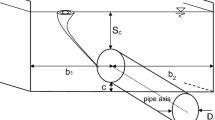Abstract
This paper focuses on the dynamic stiffness and overall equivalent damping of an air spring connected to an orifice and an auxiliary reservoir, with respect to the displacement excitation frequency, orifice area, and auxiliary reservoir volume. A theoretical model of this air spring with its auxiliary reservoir is derived by utilizing the energy conservation equation, gas state equation, and orifice flow rate equation. Simulation results from the presented model reveal that, when the air spring is subject to harmonic displacement excitation, its dynamic stiffness increases with an increase in excitation frequency and decrease in orifice area. Smaller orifice areas and lower excitation frequencies result in higher overall equivalent damping. A validation experiment is also implemented. When compared with experimental results, simulations show consistent varying trends of the dynamic stiffness and overall equivalent damping. The model developed here can correctly describe the behavior of the air spring with auxiliary reservoir, indicating that it is reasonable and feasible.
Similar content being viewed by others
Abbreviations
- A :
-
orifice area
- A e :
-
air spring effective area
- c e :
-
overall equivalent viscous damping
- c r :
-
rubber damping coefficient
- C p :
-
specific heat at constant pressure
- C v :
-
specific heat at constant volume
- C V :
-
discharge coefficient
- E :
-
air overall energy
- f :
-
frequency
- F :
-
air spring output force
- F pp :
-
force peak-peak value
- h in :
-
enthalpy flowing into
- h out :
-
enthalpy flowing out
- J pp :
-
force difference at 0 displacement
- k dyn :
-
air spring dynamic stiffness
- m :
-
air flow mass
- M :
-
air mass
- P :
-
absolute pressure
- P a :
-
atmospheric pressure
- q m :
-
air mass flow rate
- Q :
-
heat exchanged
- R :
-
gas constant
- T :
-
air temperature
- U :
-
air internal energy
- V :
-
air volume
- W :
-
work done by the outside
- W d :
-
energy loss
- x :
-
displacement
- X 0 :
-
displacement amplitude
- ω :
-
frequency
- κ :
-
specific heat ratio
- 1:
-
air spring
- 2:
-
auxiliary reservoir
- 0:
-
initial value
References
Balakumar, B. and Edward, B. M. (2004). Vibrations. Books/Cole Publishing. USA. 174–181.
Giuseppe, Q. and Massimo, S. (2001). Air suspension dimensionless analysis and design procedure. Vehicle System Dynamics, 35, 443–475.
He, L. (2006). Research on the Vertical Stiffness and Damping of the Air Spring with Auxiliary Chamber by Test. M.S. Thesis. Nanjing Agricultural University. 50–52.
Katsuya, T. and Chuuji, Y. (1999). Study on dynamic characteristic analysis of air spring with auxiliary chamber. Society of Automotive Engineers of Japan Inc., 20, 349–355.
Kim, D. J., Kim, M. K. and Hong, M. S. (2004). The Latest Pneumatic Engineering. Bookshill Press. Korea. 47–56.
Kim, I. S. and Hwang, S. H. (2002). The study on the improvement of dynamic characteristics with multiorifice in airspring. Spring Con. Proc. Korean Society of Noise and Vibration Engineers, 97–103.
Korean Standards Association (2002). Air Spring for Trucks and Buses. KS R 2057.
Lee, S. J. (2010). Development and analysis of an air spring model. Int. J. Automotive Technology 11,4, 471–479.
Liu, H. and Lee, J. C. (2009). Research on hysteresis characteristics of an automotive air spring. Proc. 7th Int. Conf. Fluid Power Transmission and Control, 574–578.
Liu, H. and Lee, J. C. (2011). Model development of automotive air spring based on experimental research. IEEE 2011 3rd Int. Conf. Measuring Technology and Mechatronics Automation (ICMTMA), 2, 585–590.
Park, H. S. and Lim, E. G. (1998). Air-spring with dual spring rates for vehicle suspension, Spring Conf. Proc. Korean Society of Automotive Engineers, 878–883.
Perry, R. H. and Green, D. W. (2008). Perry’s Chemical Engineers’ Handbook. 8th Edn. McGraw-Hill Professional Publishing. USA. 6-22–6-26.
Schaefer, R. J. (1994). Dynamic properties of rubber. Rubber World, 211, 17–19.
Seo, J. J. (2000). Hydraulic-Pneumatic. Hyungseul Press. Korea. 25–27.
Williams, R. A. (1997). Automotive active suspensions part 1: basic principles. Proc. IMechE, Part D: J. Automobile Engineering, 211, 415–426.
Williams, R. A. (1997). Automotive active suspensions part 2: practical considerations. Proc. IMechE, Part D: J. Automobile Engineering, 211, 427–444.
Young, R. J. and Lovell, P. A. (1991). Introduction to Polymers. USA. 322–344.
Zhu, S. H., Wang, J. S. and Zhang, Y. (2008). Research on theoretical calculation model for dynamic stiffness of air spring with auxiliary chamber. IEEE Vehicle Power and Propulsion Conf. (VPPC), 3–5.
Author information
Authors and Affiliations
Corresponding author
Rights and permissions
About this article
Cite this article
Liu, H., Lee, J.C. Model development and experimental research on an air spring with auxiliary reservoir. Int.J Automot. Technol. 12, 839–847 (2011). https://doi.org/10.1007/s12239-011-0096-7
Received:
Revised:
Published:
Issue Date:
DOI: https://doi.org/10.1007/s12239-011-0096-7




